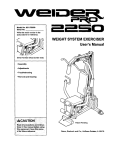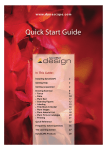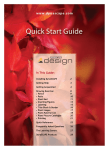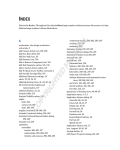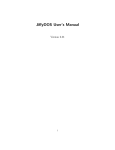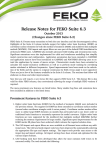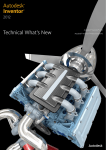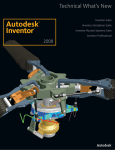Download Autodesk 666C1-000110-S001 computer aided design (CAD) software
Transcript
Technical What’s New Autodesk Inventor ® ® 2010 Autodesk Inventor Autodesk Inventor Routed Systems Autodesk Inventor Simulation Autodesk Inventor Tooling Autodesk Inventor Professional Technical What’s New Contents Welcome to Inventor 2010�����������������������������������2 Assembly Management���������������������������������������8 Plastic Part Design����������������������������������������������3 User-defined Assembly Folders���������������������������������������8 Multibody Parts�������������������������������������������������������������������3 Enhanced Assembly Restructure �����������������������������������8 Inserting Components in Parts���������������������������������������3 User Coordinate Systems�������������������������������������������������8 Silhouette Curve�����������������������������������������������������������������3 Assembly Productivity Tools��������������������������������������������9 Technical Plastic Features�������������������������������������������������3 Sheet Metal Design���������������������������������������������9 AliasStudio to Inventor�����������������������������������������������������3 Contour Roll�������������������������������������������������������������������������9 Mold Design������������������������������������������������������������������������ 4 Rip������������������������������������������������������������������������������������������9 Mold Analysis �������������������������������������������������������������������� 4 Other Sheet Metal Enhancements������������������������������� 10 Mold Base Libraries ���������������������������������������������������������� 4 Weldments������������������������������������������������������� 10 Standard Mold Base Parts����������������������������������������������� 4 Groove Welds�������������������������������������������������������������������� 10 Mold Documentation������������������������������������������������������� 4 Fillet Welds������������������������������������������������������������������������� 10 Layout Design and Simulation���������������������������� 4 Drawing Manager���������������������������������������������� 11 Sketch Layouts������������������������������������������������������������������� 4 Aligned Section Views������������������������������������������������������ 11 Sketch Blocks���������������������������������������������������������������������� 4 Dual Units Display������������������������������������������������������������� 11 Make Part and Make Components���������������������������������5 Arrange Dimensions Tool������������������������������������������������ 11 Integrated Static and Modal Analysis����������������������������5 Design Accelerators������������������������������������������� 11 Unified FEA Environment for Parts and Assemblies��5 Drum Cam Generator������������������������������������������������������� 11 Optimization������������������������������������������������������������������������5 Spur Gear Improvements ����������������������������������������������� 11 Solver Performance������������������������������������������������������������6 O-Ring Generator Improvements���������������������������������� 11 Browser Improvements�����������������������������������������������������6 Bearing Generator Enhancements�������������������������������� 11 Interoperability��������������������������������������������������6 Bill of Materials�������������������������������������������������12 Shrink Wrap Assemblies����������������������������������������������������6 Assembly Level Storage of Custom Columns ������������12 AEC Exchange����������������������������������������������������������������������7 BOM Editor Usability��������������������������������������������������������12 JT Translator�������������������������������������������������������������������������7 Open from BOM Editor����������������������������������������������������12 Usability and Productivity����������������������������������7 Better Integration of BOM Editor and Graphics Window����������������������������������������������������������������������������������������12 User Interface Enhancements�����������������������������7 Task Oriented Ribbon��������������������������������������������������������7 Document Tabs��������������������������������������������������������������������7 2D Spline Behavior�������������������������������������������������������������7 Improved Loft Usability�����������������������������������������������������8 XYZ Axis Indicator Labels�������������������������������������������������8 Licensing, Installation, and Deployment�������������12 Dynamic Licensing������������������������������������������������������������12 FLEXnet��������������������������������������������������������������������������������12 Multiple Language Support���������������������������������������������12 Combined CAD Manager Control Utility���������������������12 Auto Save������������������������������������������������������������������������������8 MDT Translator Improvements���������������������������13 Content Management�����������������������������������������8 iFeature Enhancements��������������������������������������13 Desktop Content����������������������������������������������������������������8 Material Guide��������������������������������������������������������������������8 Improved Measure Command ���������������������������������������13 Other Enhancements ����������������������������������������13 Edit Family Tables in Excel������������������������������������������������8 Autodesk Inventor 2010 Technical What’s New Welcome to the Autodesk® Inventor® 2010 software product line The Autodesk® Inventor® 2010 software product line offers many significant usability and productivity enhancements that will benefit users who need to create, optimize, and validate designs involving plastic parts, sheet metal parts, and large assemblies. Major areas of focus in this release include the following. Plastic Part Design Multibody workflows, specialized plastic features, rule-based fillets, and associative import of exterior or A-side geometry from Autodesk® AliasStudio software provide Inventor 2010 the tools for designing complex molded parts (that update smoothly when changed) without requiring a lot of detailed geometry construction or intermediate steps. The Autodesk Inventor software product family includes a new application, Autodesk Inventor Tooling (included in Autodesk® Inventor® Professional software), for designing complex molded parts. It includes automated tools that leverage a digital prototype to quickly create and validate complete mold designs, reducing errors and improving mold performance. Simulation and Layout Design The new sketch blocks in Inventor 2010 provide a logical representation of both rigid and moving bodies that can be combined into 2D kinematic models for detailed motion studies on different mechanisms. Inventor sketch blocks can be used to populate the assembly with correctly constrained part models based on the selected sketch. Inventor 2010 offers a new integrated simulation environment for motion simulation and finite element analysis (FEA) of both parts and assemblies. Support for modal analysis, parametric studies, and optimization helps make it much easier to perform what-if studies to select the best design option and then push the resulting geometry back into the assembly model. Interoperability and Data Exchange With the new Shrinkwrap feature users have a new level of control over the simplification of large assemblies. You can quickly convert an assembly into a single part or surface model for use as an assembly substitute or to protect intellectual property when sharing models with third parties. The enhanced AEC Exchange tool simplifies the exchange of data for use in building design. With support for the new Autodesk Package files (.adsk) and the Shrinkwrap tool, AEC Exchange allows users to publish data files with simplified 3D representations and intelligent connections points for use in building models created using Autodesk® Revit® MEP software and Autodesk® Revit® Architecture software. Inventor 2010 includes new translators for CATIA® V5 R6 through R18 as well as enhanced JT™ support for reading and writing JT files. Usability and Productivity Usability and productivity are enhanced with the introduction of a modern task based user interface and a large group of user requested enhancements including user-defined browser folders, user-defined coordinate systems, document tabs, improved spline handles, XYZ axis indicators, Auto-save option, and many more. This release includes new sheet metal tools that simplify the creation of rolled features and lofted flanges such as square to round transitions. It also provides Unfold and Refold features making it much easier to define features in the flat. Drawing manager highlights include aligned section views, dual units display, and a very cool arrange dimensions tool. Inventor 2010 includes many enhancements designed to lower the cost of ownership: local, or desktop, content that does not require installation of SQL/IIS on the user’s desktop, dynamic network licenses, and language packs. Thank you for your continued support of Autodesk Inventor, The Inventor Team 2 Autodesk Inventor 2010 Technical What’s New Plastic Part Design Autodesk Inventor software offers plastic parts designers maximum flexibility by combining native Inventor geometry with exterior surface models designed in Autodesk® Alias software family of products or other Industrial design applications. In addition, Autodesk Inventor software helps automate key aspects of the design of injection molds for plastic parts. This allows you to quickly create and validate complete mold designs, reducing errors and improving mold performance. Multibody Parts With the introduction of multibody part files, top-down design has never been easier. You can create new solid bodies in a part file, import solid bodies using the Derive workflow, and use one or more of the bodies as tool bodies with the new Combine command to define cut, join, or intersect operations on a selected solid. The new Move Bodies command allows you to free drag or accurately move bodies in a multibody part. Each move appears in the browser and can be edited, suppressed, or deleted like all other features. Inserting Components in Parts The Derive command contains powerful new features to support multi-body parts. A derived part no longer requires a “blank” document state. You can use the Derive command to insert parts or assemblies into a part file as: 1. A single solid body with merged seams 2. A single solid body with seams (retains component colors) 3. Maintain each solid as a solid body (all parts become “bodies”) 4. A single composite surface Options 1 and 2 work well to insert tool body components for a cut, join, or intersect operation. Option 3 results in multiple solid bodies. If you use option 4, you cannot use the resulting surface as a tool body. A component imported as a surface can be used as the split tool for a split body operation. 3 Silhouette Curve A new 3D sketch command called Silhouette Curve is introduced. A silhouette curve is a 3D curve that represents the outer boundary of the outside surface of a part along the direction vector and is useful for determining the natural parting line. To split a solid, use the silhouette curve to create a boundary patch surface and then use the Split command with the Split Solid option to create two bodies. Technical Plastic Features New Plastic Part commands are powerful rule-based tools designed to automatically create complex plastic part features. Specify the design rules in each tab of the appropriate dialog box and then click OK to create the feature. The following feature types are supported in this release. •Multi-element grill for use as vents or openings on a body •Bosses for threaded fasteners with support for head and thread sides in the same feature •Rests to form a flat area on a curved body •Hook and loop style Snap Fits to physically join bodies •Rule Fillets that work by telling the feature how to discover the edges. The Rule Fillet command is not exclusively for plastic parts. It can create fillets on any type of feature based on the specified design rules. AliasStudio to Inventor Autodesk AliasStudio WIRE files are now supported in the File Open, Insert Import, and Drag and Drop commands. You can select which surfaces to bring into Inventor and use the resulting surfaces with the existing modeling tools, including Sculpt, Stitch, and Thicken, to generate 3D part models. These enhancements reduce development time for molded parts with complex external surfaces. The imported AliasStudio data maintains associative links to the original WIRE file allowing changes made in AliasStudio to be quickly reviewed and incorporated into the Inventor model. Autodesk Inventor 2010 Technical What’s New Tooling Design Layout Design and Simulation Mold Design Autodesk Inventor software includes easy-to-use mold design features that work directly from Inventor 3D models of plastic parts to simplify part preparation, patch and parting surface creation, automated core and cavity design, runner and gate design, and cooling channel design. Full associativity to the Inventor digital model helps ensure that any changes to the model are automatically reflected in the mold design. Getting the initial design concept right is the key to a successful project. Move your initial design studies from paper by using the new sketch block capabilities in Autodesk Inventor 2010 software to develop initial concept sketches and kinematic models. Then take advantage of the enhanced simulation environment, which provides improved support for motion simulation and static and modal finite element analysis at both the part and assembly level. Mold Analysis Inventor software includes Moldflow® plastic flow analysis tools. Use them to determine material flow rates, gate locations, shrinkage, and process parameters. Mold analysis enables you to optimize your design and minimize the number of mold iterations, helping to save time and money. Mold Base Libraries Reuse standard mold bases across the organization, enabling you to avoid duplicate work while taking advantage of proven design knowledge. Inventor provides a single database that stores and delivers easy access to a wide range of mold base catalogs, including DME, Futaba, HASCO, LKM, Pedrotti, Polimold, Rabourdin, and Strack. When required, you can efficiently customize standard mold bases to suit your needs. Sketch Layouts Create a layout using 2D sketch geometry to represent your design components and configurations. Use the layout to position your components and evaluate design feasibility. When component representations in the layout are derived into part and assembly models, associativity is maintained between the layout and the components. Therefore, when changes are made to the layout or component representations, the 3D models are updated. Sketch Blocks Use sketch blocks to group 2D geometric configurations that repeat in your models. After you define a block, you place instances of the block to represent component instances. Sketch block instances are associated with their definitions so geometric modifications to the definitions apply to all instances. Use sketch blocks in your layouts to facilitate a topdown design workflow. Define nested sketch blocks and place flexible instances of these blocks to study assembly kinematics. These flexible instances retain specified degrees of freedom that allow them to simulate the kinematics of the components under design. Standard Mold Base Parts Help improve productivity and avoid errors by reusing existing mold design knowledge as you create the detailed mold design in 3D. Begin by selecting mold base components from standard catalogs, including DME, HASCO, LKM, Meusburger, Misumi, National, Progressive, Punch, and Sideco. Design or modify standard components, such as sliders, lifters, ejectors, sprue bushings, and locating rings. When you have standard mold base components that meet your needs, you can export them as templates for future use. Mold Documentation Reduce mold design lead time by generating drawings and bills of materials (BOMs) automatically. Inventor allows you to automatically create 2D drawings of mold designs and related BOMs for use in documentation or manufacturing. When you make changes to the 3D design model, Inventor automatically updates the drawings and BOMs. 4 Autodesk Inventor 2010 Technical What’s New Make Part and Make Components Create your layout and investigate your design. When you are satisfied with the design state, use the Make Part or Make Components workflow to derive sketch block instances into part or assembly file component instances. The component instances remain associated with the block instances and layout, so changes you make to the block definitions or layout are reflected in the part and assembly files. The Make Components command translates sketch constraints between blocks to assembly constraints so all of the assembly kinematics can be created and maintained associatively from the layout. In addition the Make Part command can be used with the new solid bodies to quickly produce multiple parts from a single multibody part and assemble them in an assembly. Unified FEA Environment for Parts and Assemblies A single stress analysis environment provides you with control over: •Material selection— change materials, update the simulation, and see the results. •Constraint and Load definition—specify the boundary conditions for your analysis. •Contact conditions— use automatic contacts and manual contacts to define the component relationships. •Mesh definition—global and local mesh controls provide optimum refinement for analysis conditions. •Representations—use design and level of detail representations to simplify the model. Use positional representations to analyze the model in a specific position. •Component visibility and exclusion—use these options to further simplify the model by removing components from being analyzed. Optimization Assembly optimization automatically seeks the parameter values that meet the specified design criteria. Integrated Static and Modal Analysis Easy-to-use integrated finite element analysis makes it possible to analyze your design without translating the CAD model or moving the data to another product. You can perform both static and modal analysis to examine deformation, and maximum and minimum stresses, enabling you to design higher-quality parts and ensure your design meets required safety factors. You can promote the parameter values, resulting from the studies or optimization, back into the Inventor assembly model to update the part/assembly with parameters selected during during the simulation studies. Create parametric studies, using the Parametric table, to identify design constraints and parameter ranges. Then use the parameter table controls to visualize the effects of parameter changes on your design. 5 Autodesk Inventor 2010 Technical What’s New Solver Performance Autodesk Inventor 2010 software uses new solver technology to provide improved performance for complex assembly analysis and the exploration of multiple design variations in parametric studies. Interoperability Autodesk Inventor 2010 software simplifies interdisciplinary collaboration in the building sector with simplified exchange of 3D mechanical systems data between building systems suppliers and the building designers. Inventor 2010 expands an already comprehensive suite of translators with support for CATIA V5, including native translators that read and write files from other CAD tools and translators for industry standard formats such as IGES and STEP. Shrink Wrap Assemblies The new Shrinkwrap tool converts an assembly into a single part file. The part file can be a solid or a composite surface. The default setting produces a compact composite surface file that retains all of the colors of the original part bodies. You can use the Shrinkwrap tool to: •Hand off a dimensionally accurate envelope of the assembly exterior to an architecture, engineering, and construction partner. •Protect intellectual property by concealing holes and parts. •Create an assembly that is greatly reduced in size for use as an assembly substitute. Browser Improvements The Dynamic Simulation browser has been updated to be consistent with the Inventor model browser. The browser icons are familiar and have the same meaning. Assembly commands are available, when applicable, from the context menus in the simulation environment. Additionally, this synchronization exposes the constraints that make up each joint, giving you an immediate picture of the relationship of the constraints and joints. 6 Autodesk Inventor 2010 Technical What’s New AEC Exchange The new Export Building Components command replaces the ABS Catalog Editor command in AEC Exchange. This command saves model geometry, properties, and connectors to an Autodesk Design Package (.adsk) file. The .adsk file can be imported into other Autodesk applications such as Autodesk Revit MEP or AutoCAD MEP software. When creating Duct and Pipe connectors, there are new fields for System Type and Properties. The System Type controls which properties are available for the connector and the default values. A new connector type called Electrical connector has been added to the AEC Exchange environment. This connector type supports electrical connections, including power, telephone, alarm systems, and others. Usability and Productivity Continued investment in improving the usability across the product results in better workflows and increased productivity. Improvements are to be found in the core user interface as well as application areas including the drawing manager, assembly management, content management, sheet metal design, design accelerators, weldments installation, and licensing. The following sections discuss these enhancements in more detail. User Interface Enhancements Task Oriented Ribbon The new Autodesk Inventor user interface provides access to commands on a ribbon in place of the menu and panel bars. The ribbon provides a single, compact placement for operations that are relevant to the current task at hand. The File menu has been replaced by the Application menu, which provides access to commands used to work on a file as a whole. Access the Application menu by clicking on the Autodesk Inventor product icon located on the upper far left of the product interface. Located just above the ribbon is the new Quick Access toolbar, which you can use to store commands that you use frequently. CATIA V5 Translator The new CATIA V5 translator gives you more flexibility when working with vendors or customers that use CATIA. You can import CATIA V5 files, versions R6 through R18, avoiding the need to use STEP or IGES. The new translator reads both CATPart and CATProduct files, bringing solids, surfaces, wires, and points into Autodesk Inventor where they can then be used directly in modeling operations. The CATIA translator also exports models with support for CATIA V5 versions R10 through R18. JT Translator The existing JT export using tessellated surfaces is enhanced with support for the JT precise (B-rep) format. You can now import models with precise surface data to support projects that require you to work with JT files for effective collaboration with vendors or customers. You can also export Inventor models as precise JT files with the Save Copy As workflow. Supports JT Versions 8.2, 9.0, and 9. 7 Document Tabs Each open document has a tab displayed along the bottom of the Inventor window making it possible to switch between open documents with a single mouse click. 2D Spline Behavior Tangent handles now display in a passive state when you create a spline. You can now click anywhere on a passive handle to activate it. Two new commands are introduced to simplify a spline handle reset: Reset All Handles and Reset Handle. The word Bowtie is gone, and all options are available in the root context menu. Endpoints are square, and fit points are diamond shaped to help identify joined sections. Autodesk Inventor 2010 Technical What’s New Improved Loft Usability The process for creating lofted features involves multiple selections to define the section profiles and guide paths. You can use the dialog box to switch between selecting the profile sections, rails, and centerlines, or you can right-click and use the context menu. Previous releases of Autodesk Inventor did not have a context menu for the loft command. You returned to the dialog box each time you changed the selection type. The function to right-click and use a context menu to change the selection type is added. XYZ Axis Indicator Labels X, Y, and Z labels are added to the ends of the respective arrows of the XYZ indicator that appears in 3D views, part sketches and drawing sketches. Auto Save The new Auto Save function provides a save reminder after a specified time period if your file needs to be saved. You are provided with the option to launch a standard File>Save request and save the document in which you are working and its dependents. Alternatively, you can click X to close the bubble temporarily, and continue the timer, or click “Do not show this message again” to turn off or turn on the Save Reminder behavior. Content Management Desktop Content If you are a stand-alone user, you can now store Content Center libraries on your computer in the Desktop Content folder. This new option provides improved performance and eliminates the need to install Microsoft® SQL and IIS on the desktop. Material Guide The Material Guide provides a streamlined environment for adding material information to content. It includes options for adding materials such as new Families or new Family members and for adding a material designator to File Name and Part Number. There is also an option to remove existing materials that are no longer needed. Edit Family Tables in Excel You can export the family table in Microsoft® Excel®, edit the data, and then import the data back to the family table. Assembly Management User-defined Assembly Folders With browser folders, you can organize the browser to more readily communicate design intent through logical groupings of parts and drawing resources. Use folders to organize your assembly browser and improve workflow. Define folders, based on your chosen convention, to group browser nodes. Enhanced Assembly Restructure Using Autodesk Inventor software, you can place or create a component in an assembly without worrying where it will reside in the final assembly structure. You can restructure an assembly by moving parts, groups of parts, component patterns, or entire subassemblies within the browser hierarchy without changing the physical position of previously placed parts. Inventor will maintain constraints between components when the assembly is restructured wherever possible. User Coordinate Systems The new user coordinate system, or UCS, introduces more flexibility and simplifies many advanced design workflows. Commands are provided to create a UCS in parts, assemblies, and drawings. Examples of the application of user coordinate systems include: •Moving sketches with respect to reference geometry •Changing the location of the 0, 0, 0 origin point, XY plane, and Z axis The user coordinate system is useful for entering coordinates, creating 3D objects on 2D workplanes, and rotating objects in 3D. 8 Autodesk Inventor 2010 Technical What’s New Assembly Productivity Tools Twelve tools that enhance assembly productivity are included with this release. These tools were previously available as an optional install. •Rename Browser Nodes—This tool provides key enhancements and the ability to identify all component nodes within an assembly using one of three naming schemes: filename, part number, or the default. Lofted Flange The Lofted Flange provides the ability to create a transition from one shape to another using two profiles and to create these types of geometry. Selection of two closed profiles such as a rectangle and a circle will •Add Part—This tool provides a streamlined version of Inventor software’s default Create Component command using a part file as the default. •Add Subassembly —This tool provides a streamlined version of Inventor software’s default Create Component command using an assembly file as the default. •Save and Replace Component—This tool allows you to select a component, save a copy, and replace the component with the saved copy. Sheet Metal Design Contour Roll Similar to the Contour Flange feature, the Contour Roll requires an open profile sketch as input. Additionally, the Contour Roll feature also requires the identification of a sketched axis of revolution as well as an angle. Offset direction options allow both the material thickness and angle to be offset to one side or the other of the selected profile or to use the selected profile as the midplane of the material thickness or swept angle. Contour Roll features may be unrolled using the Unfold feature. The resulting straight section may be further unfolded, allowing the addition of features to the model in a flattened state. This flat model can then be refolded and rerolled. 9 commonly be used to create parts similar to HVAC ducting, material handling hoppers, exhaust hoods, etc. In addition, the Lofted Flange will accept two open profiles, or one closed and one open profile. The profiles need not be parallel to each other. An important consideration in the creation of a Lofted Flange is the manufacturing process used to produce the part. The Lofted Flange feature provides output options that support both die-forming and press brake fabrication. The die-form option produces smooth transitions from one end to the other. The press brake option automatically decomposes the shape into a number of flat faces and straight bends. Rip Rip provides an easy way to add a gap in a Lofted Flange that will allow the model to flatten. The rip feature is defined by identifying a point on one edge of the face or by identifying two points—one on either side of the selected face. A Rip feature can also be created by removing an entire face—often a bend face between two shape defining faces. Unfold/Refold Feature Pair These two features are typically used as a pair. The Unfold feature can be added to a folded sheet metal model to allow the unfolding or unrolling of an existing feature. Once the folded model has unfolded features it is likely that features will be added that are most easily defined in the flat. Following adding these features, a Refold feature returns the model to the original folded state. Autodesk Inventor 2010 Technical What’s New Bend Order Annotation Features containing bends are created in a logical sequence during the design of a folded part model; however, it is rare that the fabrication of those bends during manufacturing will follow the same sequence. The Bend Order feature provides a means of specifying a desired fabrication sequence to bends (including Cosmetic Centerlines) identified in the flat pattern. Other Sheet Metal Enhancements •The Move Face feature is now available as a feature that can be applied while working within the flat pattern. •GapSize has been added as a system parameter that can be used in value declarations. •Sheet Metal Unfold Rules can now utilize Custom Unfold Equations to define the bend zone deformation applied when creating a flat pattern. An equation editor and a bounding condition editor have been added to the Style and Standard Editor for Sheet Metal Unfold Rules to allow the definition of equations and the conditions for using the equations. •The width type of a specific bend from among a group of bends created as a single feature can now be edited by selecting the Bend Edit glyph during the creation or edit of a Flange or Lofted Flange feature. Weldments Bends can be re-sequenced by: 1) selecting a beginning bend and an ending bend and allowing the system to reorder the bends that fall between, 2) by selecting bends in the sequence desired, or 3) by applying a specific bend order identification number to a selected bend. The Bend Order specified is subsequently recovered when a Bend Table is created on a drawing containing a flat pattern view. Cosmetic Centerlines There will be designs where you need a bend centerline in your flat pattern for a feature that does not exist in your folded model. A common example of this would be for a stiffening crease. Another example would be the addition of one or more bend lines on the flat pattern of a die-formed design. The Cosmetic Centerline feature allows you to select straight lines sketched on the flat pattern and define these lines as bend centerlines with bend direction and angle attributes. Groove Welds Groove welds have a new Fill Direction option called Radial Fill. Use Radial Fill to satisfy conditions that do not require a linear direction and avoid the need to split faces. A new Chain Faces option is added to allow you to easily group face selections. Fillet Welds Fillet welds have new functionality that allows the weld to span a gap that is smaller than the specified weld bead. A new Start-Length option is added to allow specifying the Start position and Length of the weld. Use the Direction arrow to reverse the start position if required. Once a sketched line is declared to be a Cosmetic Centerline, it will display bend extent lines in the flat pattern. Cosmetic Centerlines can also be recovered in flat pattern drawing view bend notes and bend tables. 10 Autodesk Inventor 2010 Technical What’s New Drawing Manager Design Accelerators Aligned Section Views Generate align section views on views where the section line consist of two or more line segments. Aligned or Projected methods of aligned section views are controlled in the Section View dialog box. Dual Units Display Dual units can be displayed on Hole Notes, Chamfer Notes, Bend Notes, Punch Notes, Hole Tables, Bend Tables, and Punch Tables. Drum Cam Generator A new Drum Cam Generator was added to the Design Accelerator design tools. It is located in the Design tab in Assemblies. It enables you to design and calculate drum cams, perform the strength check, and insert them into the assembly. The dual units display behavior is controlled by new controls on the Alternate Units tab in dimension style for all note types. Arrange Dimensions Tool A new command in the Annotate panel enables you to arrange groups of selected dimensions (linear, angular, coordinate, true isometric dimensions). You can select dimensions in the drawing first, and then execute the Arrange Dimensions command. Alternatively, you can click the Arrange Dimensions command first, and then select the dimensions in the drawings. You can select dimensions that lie along one axis or dimensions arranged along multiple axes. You can arrange dimensions in one or multiple views. Spur Gear Improvements You can now export exact tooth geometry from spur gears as well as manually adjust backlash in order to achieve appropriate working and manufacturing conditions for your spur gear set. An improved preview option provides animated previews showing gear teeth mesh as well as pinion-to-rack mesh and gear-to-rack mesh. O-Ring Generator Improvements Using O-Ring Component Generator you can now pattern radial and axial O-rings. Bearing Generator Enhancements A new Orientation button in the Bearing Generator makes it easy to flip the bearing orientation to simplify the addition of bearings that must be oriented correctly such as tapered and angular contact bearings. The bearing remains in the same position mated to the same reference plane while the orientation its orientation is changed by 180 degrees. User-defined Symbol Folders Use folders to organize your sketch symbols in the Drawing Resources. Define folders under Sketched Symbols and group the appropriate symbols within. If you find that you recreate the same symbol folders repeatedly for different drawings, consider using a drawing template with the folders predefined. User-defined symbol folders are represented by distinctive icons and they exhibit the same open and close behavior as other Inventor browser folders. 11 Autodesk Inventor 2010 Technical What’s New Bill of Materials Licensing, Installation, and Deployment Assembly Level Storage of Custom Columns Custom columns are now stored in the assembly file, making it much easier to share custom BOM data. Dynamic Licensing Customers with a mix of Autodesk Inventor seats (Inventor Suite, Simulation, Routed Systems, or Professional) and who use the network license manager typically install the higher-level Inventor flavor on all machines so that each user can run the version of Inventor that best meets their needs at the time. BOM Editor Usability The Bill of Materials dialog box now supports a spreadsheet usage paradigm. •Use the Shift or Ctrl key on your keyboard to control selection. •Use a grip point in the bottom-right corner of a selection to expand a single cell or block of cells. If the original selection contains a single row or column, values are copied to the expanded rows or columns. •Copy BOM cells within the BOM table, to another BOM view, or to an external editor. Copying preserves BOM formulas. •Drag and drop rows in the BOM table. The functionality is also available for noncontiguous selection sets. •Commands are available in the context menu (Copy, Paste, Capitalize, Find, and Replace). •Copy and paste data between the Bill of Materials dialog box and Microsoft Office Excel. Noncontiguous selection sets in the BOM table are supported. Open from BOM Editor Use the Open command to open a part or assembly file from the Bill of Materials dialog box. The Open command is available in the right-click menu for a selected (highlighted) component in the BOM table. Better Integration of BOM Editor and Graphics Window The BOM Editor has been enhanced so you can now pan, rotate, and zoom the model while working in the BOM Editor. In addition, you now see parts and assemblies highlighted when you select the corresponding cell or row in the BOM dialog box. Similarly, selecting a component in the assembly browser or graphic window will highlight the corresponding row in the BOM dialog. 12 In the past, switching from one version, such as Autodesk® Inventor® Suite software, to another version, such as Autodesk® Inventor® Professional software, required you to close Inventor and restart it again. With Inventor 2010 this is no longer necessary. Inventor 2010 installations using network licenses always start with an Inventor Suite license and dynamically switch licenses only when you invoke a command that requires a higher-value license. This enhancement optimizes license usage since users only consume higher-value licenses when required. FLEXnet The license manager for Inventor 2010 uses FLEXnet in place of FLEXlm. Multiple Language Support Inventor 2010 installer provides support for language packs, allowing you to select the language during installation or during the creation of a deployment. For 2010 the English language pack is included with the localized product in North and South America and all Asia regions except Japan. It is not available in EMIA regions. Combined CAD Manager Control Utility The CAD Manager Control Utilities for AutoCAD® software and Inventor have been combined into a single utility. Autodesk Inventor 2010 Technical What’s New MDT Translator Improvements Improved translation of MDT DWG™ files into Inventor drawing files including: •Option to convert all Autodesk® Mechanical annotation drawing symbols to Inventor sketch symbols •Option to map Autodesk Mechanical datum IDs, FCF, and surface texture symbols to native Inventor symbols •Thread representation improved by replacing thread representations with Inventor thread feature edges •Enhanced feature pattern and drawing dimension translation iFeature Enhancements •Easily create a table-driven iFeature from a tabledriven iPart •Flip Surface Normal upon iFeature Insertion •Key 1 values in the iFeature may be displayed in the browser •Use a table-driven iFeature in table-driven iPart in a table-driven iAssembly •Extract iFeature custom properties in the custom properties tab of the part file •Create an iFeature from a table driven iPart Other Enhancements •Balloon snap and alignment in 15-degree increments during creation reduces the need to realign balloons after placement •Projecting geometry in a drawing to a sketch associated with the view now matches the part modeling workflow. •Dimension selection filter •Refresh model properties copied to drawing properties •Open drawings from the part/assembly browser •Option to set insertion point to view center or model origin for DWG view blocks •Insert option for placing a view block in DWG model space •Recover centerlines •Dimensioning to spline end points and min/max points •Attach text to leadered annotations •Insertion of view block definitions into Autodesk Inventor DWG model space is now allowed •Ability to define view block insertion point as model origin rather than view center Improved Measure Command With the enhanced Measure command, you can now preselect entities before you start the command. If the selection set is compatible with the specified measure tool, the results display. If the selection set is not compatible with the requested measure command, the selection set is cleared. For example, if three part edges are selected before you choose to measure distance, the selection set is cleared. If one object is selected and it is compatible with the requested measure tool, the selection is retained. In assemblies, the default selection filter for the measure distance command is now set to Select Faces and Edges to support the most common workflows. The selection filter is persistent. If the filter is changed, that filter is active for the rest of the session unless a new filter is selected. A preselected set uses a different filter. A new session uses the filter defaults. Autodesk and AutoCAD are registered trademarks of Autodesk, Inc., in the USA and/or other countries. All other brand names, product names, or trademarks belong to their respective holders. Autodesk reserves the right to alter product offerings and specifications at any time without notice, and is not responsible for typographical or graphical errors that may appear in this document. © 2009 Autodesk, Inc. All rights reserved.















